
Riverside Museum in Glasgow by Zaha Hadid
Panta rhei - everything flows
On June 21, 2011, the new Scottish Transport Museum, Riverside Museum, was officially opened in Glasgow. The building impresses with its magnificent architecture featuring soft, flowing shapes that posed unusually high demands on designers and craftsmen.
Glasgow is an important transport hub of Scotland with a long tradition in domestic and international transport. Since the end of the 18th century, the city has become a significant transshipment point for overseas trade due to its location on the River Clyde. Trains and ships were built in factories and shipyards, and in 1896 the third oldest underground railway was put into operation. Today, four motorways intersect here, and two airports connect the city to international air traffic.
Residents and visitors of Glasgow can admire this tradition and the development of the city at the transport museum since 1964. The museum was originally located in a former tram depot and from 1987 at the Kelvin Hall exhibition center. However, as not all exhibits could be housed there, it was decided to build a new building, which was constructed right by the River Clyde and also aimed to enhance the dock area.
The project and realization contract was awarded to Pritzker Prize winner Zaha Hadid from London. She designed a building that, due to its unusual and distinctive architecture, represents a new attraction for the port of Glasgow. In form and layout, the new Riverside Transport Museum resembles a irregularly folded napkin bent in two. Its beginning and end consist of fully glazed gables. Here, visitors embark on their journey through the museum's tunnel, where their gaze is captured by 3,000 key exhibits. In the museum, you can experience and admire motorcycles, cars, trams, buses, locomotives, and a faithfully replicated street scene with all your senses. The various exhibition spaces connect as smoothly as the calm traffic on the road or the water in the River Clyde. The visible lower folds of the folded napkin that form the ceiling of the exhibition spaces highlight the direction of the tour and easily guide visitors through the museum.
Visitors may be stopped or forced to take small "detours" only by the exhibits, as the museum is entirely pillar-free inside the tunnel, and no obstacles hinder the flow of visitors. This was made possible thanks to the folded steel structure that spans a width of 35 meters and a length of 167 meters. It has support only in the middle of the museum through two meandering bends that provide stability to the steel structure.
Soft, flowing transitions also characterize the museum's exterior design. The façades and roofs blend seamlessly without visible connections. The outer surface of the roof faithfully reflects the internal protruding, meandering elevations and valleys with a height difference of up to 10 meters.
Glasgow is an important transport hub of Scotland with a long tradition in domestic and international transport. Since the end of the 18th century, the city has become a significant transshipment point for overseas trade due to its location on the River Clyde. Trains and ships were built in factories and shipyards, and in 1896 the third oldest underground railway was put into operation. Today, four motorways intersect here, and two airports connect the city to international air traffic.
Residents and visitors of Glasgow can admire this tradition and the development of the city at the transport museum since 1964. The museum was originally located in a former tram depot and from 1987 at the Kelvin Hall exhibition center. However, as not all exhibits could be housed there, it was decided to build a new building, which was constructed right by the River Clyde and also aimed to enhance the dock area.
The project and realization contract was awarded to Pritzker Prize winner Zaha Hadid from London. She designed a building that, due to its unusual and distinctive architecture, represents a new attraction for the port of Glasgow. In form and layout, the new Riverside Transport Museum resembles a irregularly folded napkin bent in two. Its beginning and end consist of fully glazed gables. Here, visitors embark on their journey through the museum's tunnel, where their gaze is captured by 3,000 key exhibits. In the museum, you can experience and admire motorcycles, cars, trams, buses, locomotives, and a faithfully replicated street scene with all your senses. The various exhibition spaces connect as smoothly as the calm traffic on the road or the water in the River Clyde. The visible lower folds of the folded napkin that form the ceiling of the exhibition spaces highlight the direction of the tour and easily guide visitors through the museum.
Visitors may be stopped or forced to take small "detours" only by the exhibits, as the museum is entirely pillar-free inside the tunnel, and no obstacles hinder the flow of visitors. This was made possible thanks to the folded steel structure that spans a width of 35 meters and a length of 167 meters. It has support only in the middle of the museum through two meandering bends that provide stability to the steel structure.
Soft, flowing transitions also characterize the museum's exterior design. The façades and roofs blend seamlessly without visible connections. The outer surface of the roof faithfully reflects the internal protruding, meandering elevations and valleys with a height difference of up to 10 meters.
The English translation is powered by AI tool. Switch to Czech to view the original text source.
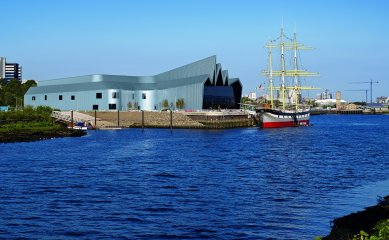
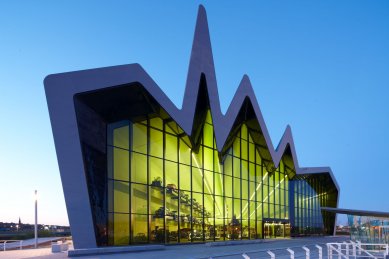
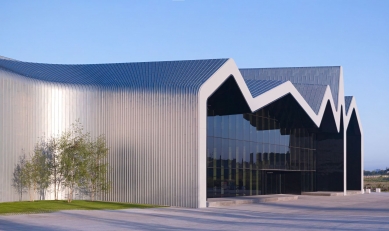
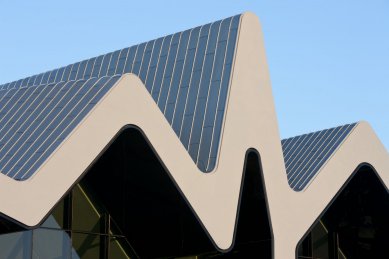
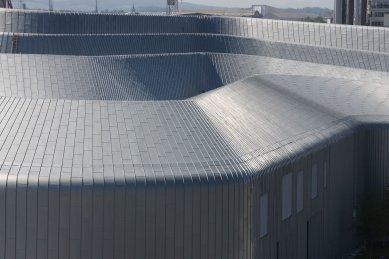

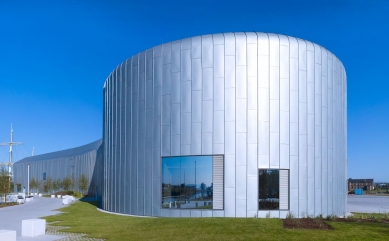
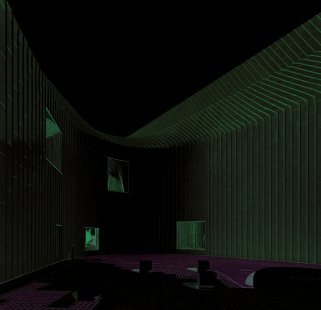
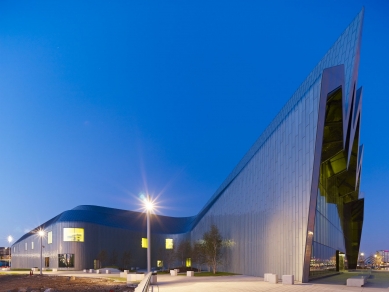
0 comments
add comment





